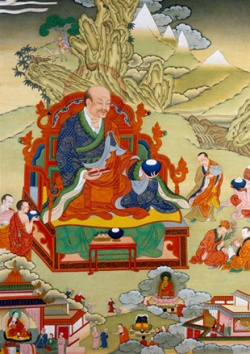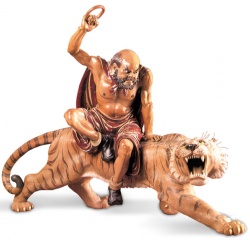Pindolabharadvaja
Pindolabharadvaja
賓頭盧 (Skt, Pali; Jpn Binzuru)
Also known as Pindola. A follower of Shakyamuni Buddha. Although he was the son of a minister to Udayana, the king of Kaushambi in India, he renounced the secular world to enter the Buddhist Order and attained the state of arhat. It is said that he excelled in supernatural powers, but that Shakyamuni Buddha rebuked him for using them when he should not and for terrifying others, though not intentionally, with those powers. Pindolabharadvaja is counted among the sixteen arhats entrusted by Shakyamuni Buddha with his teaching and who vowed to protect it after his death. Pindolabharadvaja is also written Pindola Bharadvaja.
According to the earliest Indian sutra's Pindola Bharadvaja was one of four Arhats asked by the Buddha to remain in the world to propagate Buddhist law (Dharma). Each of the four was associated with one of the four compass directions.
Pindola is said to have excelled in the mastery of occult and psychic powers. He was once remonstrated by Buddha for misusing his powers to impress simple, ignorant people.
Along with Ananda, Pindola preached to the women of Udena's palace at Kosambi on two different occasions.
In later centuries, the number of Arhats increases from four to Sixteen Arhats, then later on to 18. In Tibetan Thangka paintings depicting the 18 Arhats, Pindola Bharadvaja is usually depicted holding a book and begging bowl.
==In Japan==
In Japan, Pindola is called Binzuru (賓頭盧?), a short form of Bindora Baradaja (賓度羅跋囉惰闍?), and is arguably the most popular of all the Arhats. The monastery refectory near Todaiji Temple at Nara has a large wooden statue of Binzuru, depicting him seated in the lotus position. Statues of him are usually well worn, since the faithful follow the custom of rubbing a part of the effigy corresponding to the sick parts of their bodies, as he is reputed to have the gift of healing. Nagano, whose Zenkoji temple also hosts a well-worn Binzuru statue, stages a yearly Binzuru festival.
He is also very frequently offered red and white bibs and children's caps to watch over the health of babies, so that his statue is often decked in rags. He is represented in painting as an old man seated on a rock, holding in his hand a sort of sceptre (a Japanese shaku), or a sutra box and a feather fan. All the other Arahants are usually worshipped in Japan in his person
See also six-teen arhats.

